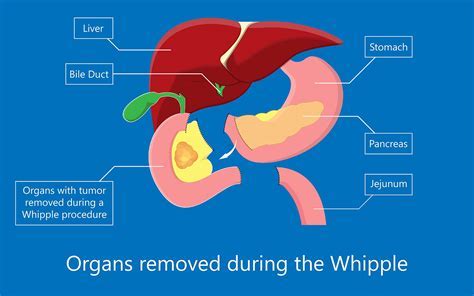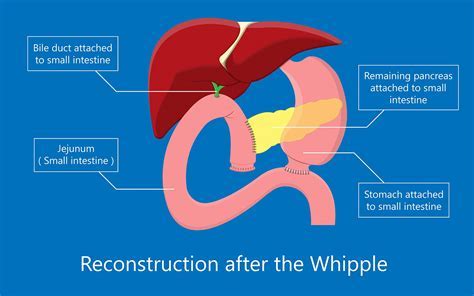Intro
Discover 5 expert tips for a successful Whipple procedure, including pancreatic cancer treatment, surgery preparation, and post-op care, to ensure a smooth recovery from this complex operation.
The Whipple procedure, also known as a pancreaticoduodenectomy, is a complex surgical operation performed to remove a tumor or other diseased tissue from the head of the pancreas, the duodenum, the gallbladder, and sometimes a portion of the stomach. This procedure is typically recommended for patients with pancreatic cancer, ampullary cancer, duodenal cancer, or other conditions affecting these areas. Understanding the intricacies of the Whipple procedure is crucial for patients and their families to make informed decisions about their care. In this article, we will delve into the details of the Whipple procedure, its benefits, the steps involved, and what patients can expect during their recovery.
The importance of the Whipple procedure cannot be overstated, as it offers a potential cure for certain types of cancer and other conditions affecting the pancreas and surrounding tissues. However, the procedure is not without risks and complications, and patients must carefully weigh the potential benefits against the potential drawbacks. As medical technology and surgical techniques continue to evolve, the Whipple procedure has become safer and more effective, offering new hope to patients who may have previously been considered inoperable.
For patients facing a diagnosis of pancreatic cancer or other conditions requiring the Whipple procedure, it is essential to seek out a skilled and experienced surgical team. The success of the procedure depends on many factors, including the skill of the surgeon, the quality of preoperative and postoperative care, and the patient's overall health. By choosing a reputable and experienced medical team, patients can ensure that they receive the best possible care and maximize their chances of a successful outcome.
Overview of the Whipple Procedure

The Whipple procedure is a major surgical operation that involves the removal of several organs and tissues, including the head of the pancreas, the duodenum, the gallbladder, and sometimes a portion of the stomach. The procedure is typically performed under general anesthesia and can take several hours to complete. During the operation, the surgeon will carefully remove the diseased tissue and reconstruct the remaining organs to restore normal digestive function. The Whipple procedure can be performed using traditional open surgery or minimally invasive techniques, such as laparoscopy or robotic surgery.
Benefits of the Whipple Procedure
The Whipple procedure offers several benefits for patients with pancreatic cancer and other conditions affecting the pancreas and surrounding tissues. These benefits include: * The potential for a cure: The Whipple procedure can be curative for certain types of cancer, such as pancreatic cancer and ampullary cancer. * Relief from symptoms: The procedure can help alleviate symptoms such as pain, nausea, and vomiting, which can significantly improve a patient's quality of life. * Improved digestive function: By removing diseased tissue and reconstructing the remaining organs, the Whipple procedure can help restore normal digestive function and prevent malnutrition.Steps Involved in the Whipple Procedure

The Whipple procedure involves several steps, which may vary depending on the individual patient's needs and the surgeon's preferences. The general steps involved in the procedure include:
- Preparation: The patient is prepared for surgery by undergoing a series of tests, including blood work, imaging studies, and other diagnostic procedures.
- Anesthesia: The patient is given general anesthesia to ensure comfort and relaxation during the procedure.
- Incision: The surgeon makes an incision in the abdomen to access the pancreas and surrounding tissues.
- Removal of diseased tissue: The surgeon carefully removes the diseased tissue, including the head of the pancreas, the duodenum, the gallbladder, and sometimes a portion of the stomach.
- Reconstruction: The surgeon reconstructs the remaining organs to restore normal digestive function.
- Closure: The incision is closed, and the patient is taken to the recovery room.
Risks and Complications of the Whipple Procedure
While the Whipple procedure can be a lifesaving operation, it is not without risks and complications. Some of the potential risks and complications include: * Infection: As with any surgical procedure, there is a risk of infection with the Whipple procedure. * Bleeding: The procedure can cause significant bleeding, which may require blood transfusions. * Pancreatic fistula: A pancreatic fistula is a complication that can occur when the pancreas does not heal properly after the procedure. * Delayed gastric emptying: Some patients may experience delayed gastric emptying, which can cause nausea, vomiting, and abdominal pain.Recovery from the Whipple Procedure

Recovery from the Whipple procedure can be a long and challenging process. Patients typically spend several days in the hospital after the procedure, where they receive close monitoring and care from a team of healthcare professionals. After discharge, patients may need to follow a special diet and take medications to manage pain and prevent complications. It is essential for patients to follow their surgeon's instructions carefully and attend all follow-up appointments to ensure a smooth and successful recovery.
5 Tips for Patients Undergoing the Whipple Procedure
Here are five tips for patients undergoing the Whipple procedure: * Choose an experienced surgeon: The success of the Whipple procedure depends on the skill and experience of the surgeon. * Follow a healthy diet: Eating a healthy diet rich in fruits, vegetables, and whole grains can help promote healing and prevent malnutrition. * Stay hydrated: Drinking plenty of water and other fluids can help prevent dehydration and promote healing. * Manage pain: Patients should follow their surgeon's instructions for managing pain, which may include taking medications and using other pain management techniques. * Attend follow-up appointments: Regular follow-up appointments with the surgeon and other healthcare professionals can help ensure a smooth and successful recovery.Conclusion and Next Steps

In conclusion, the Whipple procedure is a complex surgical operation that offers a potential cure for certain types of cancer and other conditions affecting the pancreas and surrounding tissues. While the procedure is not without risks and complications, it can be a lifesaving operation for patients who are good candidates. By understanding the benefits, risks, and steps involved in the Whipple procedure, patients can make informed decisions about their care and take the first step towards a successful recovery.
What is the Whipple procedure?
+The Whipple procedure, also known as a pancreaticoduodenectomy, is a complex surgical operation performed to remove a tumor or other diseased tissue from the head of the pancreas, the duodenum, the gallbladder, and sometimes a portion of the stomach.
What are the benefits of the Whipple procedure?
+The Whipple procedure offers several benefits, including the potential for a cure, relief from symptoms, and improved digestive function.
What are the risks and complications of the Whipple procedure?
+The Whipple procedure carries several risks and complications, including infection, bleeding, pancreatic fistula, and delayed gastric emptying.
If you or a loved one is facing a diagnosis of pancreatic cancer or another condition that may require the Whipple procedure, we encourage you to reach out to a qualified healthcare professional to discuss your options and determine the best course of treatment. Additionally, we invite you to share your experiences and ask questions in the comments section below. By working together and sharing our knowledge and experiences, we can promote greater understanding and awareness of the Whipple procedure and its potential benefits and risks.
